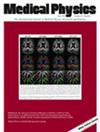Deep learning-based estimation of respiration-induced deformation from surface motion: A proof-of-concept study on 4D thoracic image synthesis
Abstract
Background
Four-dimension computed tomography (4D-CT) provides important respiration-related information for thoracic radiotherapy. Its quality is challenged by various respiratory patterns. Its acquisition gives rise to the risk of higher radiation exposure. Based on a continuously estimated deformation, a 4D synthesis by warping a high-quality volumetric image is a possible solution.
Purpose
To propose a non-patient-specific cascaded ensemble model (CEM) to estimate respiration-induced thoracic tissue deformation from surface motion.
Methods
The CEM is cascaded by three deep learning-based models. By inputting the surface motion, CEM outputs a deformation vector field (DVF) inside thorax. In our work, the surface motion was simulated using the body contours derived from 4D-CT. The CEM was trained on our private database including 62 4D-CT sets, and was tested on a public database encompassing 80 4D-CT sets. To evaluate CEM, we employed the model output DVF to generate a few series of synthesized CTs, and compared them with the ground truth. CEM was also compared with other published works.
Results
CEM synthesized CT with an mRMSE (average root mean square error) of 61.06 ± 10.43HU (average ± standard deviation), an mSSIM (average structural similarity index measure) of 0.990 ± 0.004, and an mMAE (average mean absolute error) of 26.80 ± 5.65HU. Compared with other works, CEM showed the best result.
Conclusions
The results demonstrated the effectiveness of CEM on estimating tissue DVF inside thorax. CEM requires no patient-specific breathing data sampling and no additional training before treatment. It shows potential for broad applications.


 求助内容:
求助内容: 应助结果提醒方式:
应助结果提醒方式:


